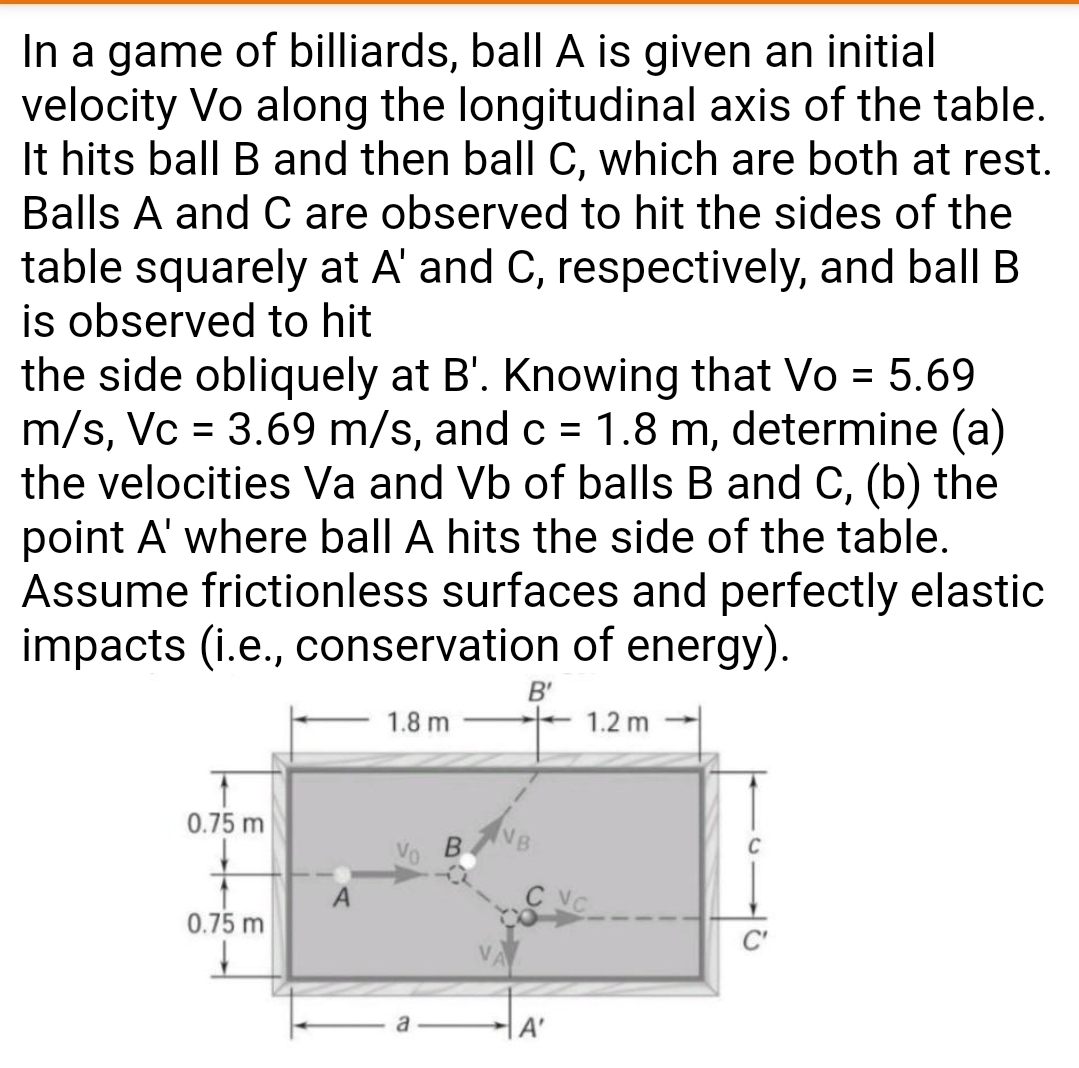In a game of billiards, ball A is given an initial velocity Vo along the longitudinal axis of the table. It hits ball B and then ball C, which are both at rest. Balls A and C are observed to hit the sides of the table squarely at A' and C, respectively, and ball B is observed to hit the side obliquely at B'. Knowing that Vo = 5.69 m/s, Vc = 3.69 m/s, and c = 1.8 m, determine (a) the velocities Va and Vb of balls B and C, (b) the point A' where ball A hits the side of the table. Assume frictionless surfaces and perfectly elastic impacts (i.e., conservation of energy). B' 1.2 m 1.8 m 0.75 m Vo B 0.75 m A'
In a game of billiards, ball A is given an initial velocity Vo along the longitudinal axis of the table. It hits ball B and then ball C, which are both at rest. Balls A and C are observed to hit the sides of the table squarely at A' and C, respectively, and ball B is observed to hit the side obliquely at B'. Knowing that Vo = 5.69 m/s, Vc = 3.69 m/s, and c = 1.8 m, determine (a) the velocities Va and Vb of balls B and C, (b) the point A' where ball A hits the side of the table. Assume frictionless surfaces and perfectly elastic impacts (i.e., conservation of energy). B' 1.2 m 1.8 m 0.75 m Vo B 0.75 m A'
Elements Of Electromagnetics
7th Edition
ISBN:9780190698614
Author:Sadiku, Matthew N. O.
Publisher:Sadiku, Matthew N. O.
ChapterMA: Math Assessment
Section: Chapter Questions
Problem 1.1MA
Related questions
Question
very urgent sir, pls try to solve it within 20 mins. I dont have much more information.

Transcribed Image Text:In a game of billiards, ball A is given an initial
velocity Vo along the longitudinal axis of the table.
It hits ball B and then ball C, which are both at rest.
Balls A and C are observed to hit the sides of the
table squarely at A' and C, respectively, and ball B
is observed to hit
the side obliquely at B'. Knowing that Vo = 5.69
m/s, Vc = 3.69 m/s, and c = 1.8 m, determine (a)
the velocities Va and Vb of balls B and C, (b) the
point A' where ball A hits the side of the table.
Assume frictionless surfaces and perfectly elastic
impacts (i.e., conservation of energy).
%D
%3D
B'
1.2 m
1.8 m
0.75 m
VB
0.75 m
C'
Expert Solution
This question has been solved!
Explore an expertly crafted, step-by-step solution for a thorough understanding of key concepts.
This is a popular solution!
Trending now
This is a popular solution!
Step by step
Solved in 4 steps with 13 images

Knowledge Booster
Learn more about
Need a deep-dive on the concept behind this application? Look no further. Learn more about this topic, mechanical-engineering and related others by exploring similar questions and additional content below.Recommended textbooks for you

Elements Of Electromagnetics
Mechanical Engineering
ISBN:
9780190698614
Author:
Sadiku, Matthew N. O.
Publisher:
Oxford University Press

Mechanics of Materials (10th Edition)
Mechanical Engineering
ISBN:
9780134319650
Author:
Russell C. Hibbeler
Publisher:
PEARSON

Thermodynamics: An Engineering Approach
Mechanical Engineering
ISBN:
9781259822674
Author:
Yunus A. Cengel Dr., Michael A. Boles
Publisher:
McGraw-Hill Education

Elements Of Electromagnetics
Mechanical Engineering
ISBN:
9780190698614
Author:
Sadiku, Matthew N. O.
Publisher:
Oxford University Press

Mechanics of Materials (10th Edition)
Mechanical Engineering
ISBN:
9780134319650
Author:
Russell C. Hibbeler
Publisher:
PEARSON

Thermodynamics: An Engineering Approach
Mechanical Engineering
ISBN:
9781259822674
Author:
Yunus A. Cengel Dr., Michael A. Boles
Publisher:
McGraw-Hill Education

Control Systems Engineering
Mechanical Engineering
ISBN:
9781118170519
Author:
Norman S. Nise
Publisher:
WILEY

Mechanics of Materials (MindTap Course List)
Mechanical Engineering
ISBN:
9781337093347
Author:
Barry J. Goodno, James M. Gere
Publisher:
Cengage Learning

Engineering Mechanics: Statics
Mechanical Engineering
ISBN:
9781118807330
Author:
James L. Meriam, L. G. Kraige, J. N. Bolton
Publisher:
WILEY